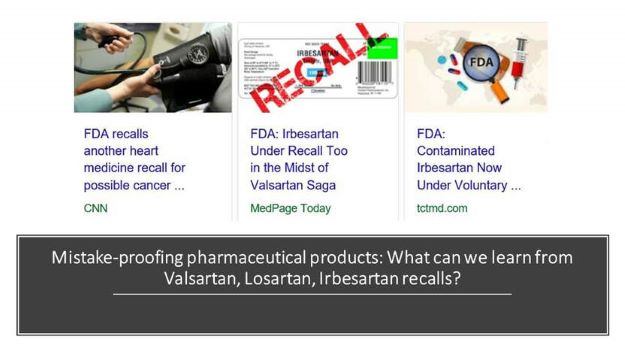For pharma companies, this is a huge hit to their brand image as well as to their bottom-line.
Even though Impurities in drugs and drug products are a part of manufacturing process, drug companies strive hard to keep them at minimal and within specifications; be it as per ICH, FDA or company's internal standards. So what happened in case of Valsartan, Irbesartan? Are compendial testing procedures adequate? How were these impurities missed?
Several such questions arise... A root cause analysis will dig into reasons for the lapse, but prevention is better than cure … this is more so true for defective pharmaceutical products. Lesson learnt from *SARTAN mishaps is as a wakeup call !
Recalls will surely stop patients from taking defective batches of Valsartan, Irbesartan. But what about the damage already done to patients who have consumed these defective products? And what is it that we must do to prevent something similar from happening again; not only for *SARTANs but any other drug or drug product?
Impurities in drug/drug products: How NOT to miss them?
Pharma R&Ds follow rigorous procedures to keep impurities/ degradation products at minimal possible levels. Drugs and drug products are developed using high standards and elaborate regulated procedures, yet how were these impurities missed out? And what to do to NOT miss them?
A thumb rule whenever a 'defect' occurs means, underlying 'processes' are faulty and must be revisited- improved or re-designed. |
Here's the starting point-
Drug and drug products are developed using ICH Quality norms, QbD (Quality-by-Design), PAT (Process Analytical Techniques) and similar such sophisticated guidances which facilitate 'risk-assessment'. Based on *SARTAN scenario, a logical question that pops up is- Are these 'risk- assessment' tools good enough? Or is there an application failure? In the former case, guidance documents need overhaul, while the later, points to inadequate training (around appropriate implementation of these guidances).
Secondly, the whole concept of 'Mistake-Proofing' pharmaceutical products must be revisited ... |
Existing IPQC, QA monitoring norms are not good enough when we deal with complex small molecule drug candidates. All processes (technical and/or operational) leading to the products must be studied comprehensively, supervised, modified and improved 'Continuously' ...
A comprehensive Continuous Improvement methodology such as Kaizen must be rooted into pharmaceutical company operations |
Besides CAPA, FMEA, QbD, ICH and compendial norms, a structured 'Mistake-Proofing' methodology such as Poka Yoke- a Japanese concept for 'Mistake-Proofing', must be adopted as an integral part of Drug Discovery and Drug Product Development programs.
Poka Yoke based Mistake-Proofing must be customized by companies for their line of business and product mix. |
You may also like:
#Manufacturing #Lean #ContinuousImprovement #Kaizen #QualityImprovement #Losartan #Valsartan #Irbesartan #USFDA #Quality #eLearning #ManufacturingManagement #Pharmaceutical #LifeSciences #LeanManagement #KaizenMasterclass #RiskManagement #Impurities





















